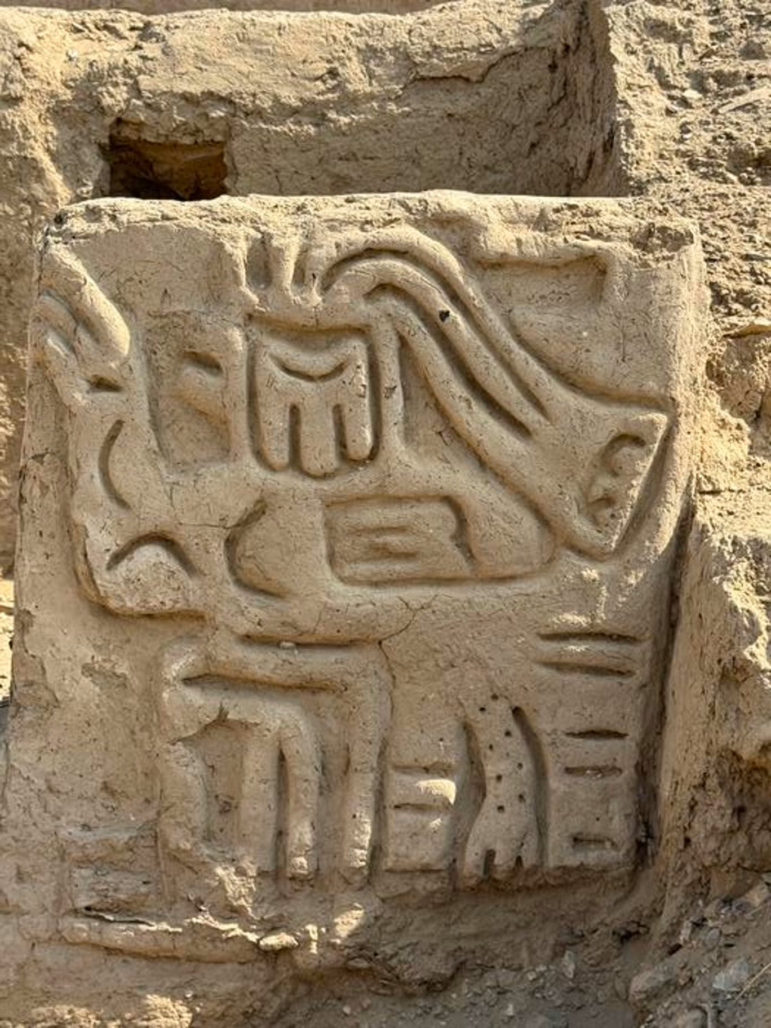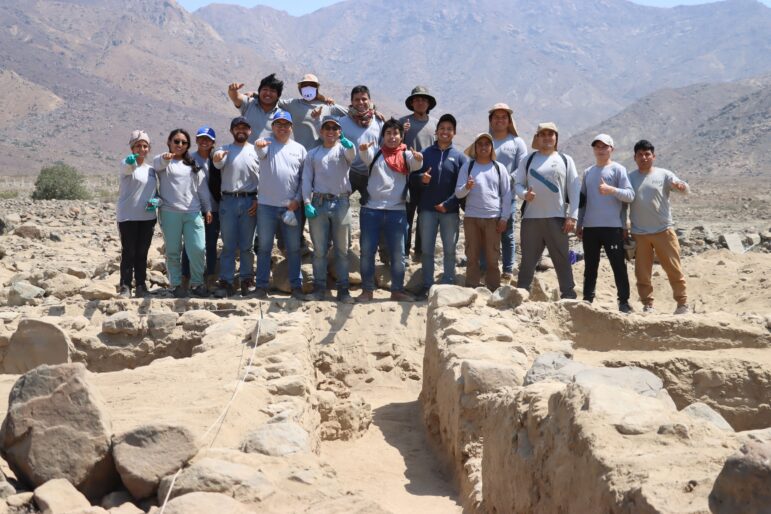
Uncovering the Past
LIMA, Peru – Last week, the Virú Valley Archaeological Research Project (PAVI) revealed an astonishing archaeological discovery that has the potential to transform our understanding of ancient history in northern Peru. The announcement, made at the Queneto archaeological site in the San Juan ravine (Virú, about 500 Km or 300 miles north of Lima), was spearheaded by PhD candidate Feren Castillo Luján and thesis student Christian González, both from the Professional School of Archaeology at the National University of Trujillo (UNT).
The team of archaeologists has unearthed the skeletal remains of four individuals, buried approximately 3,800 years ago, in Peru’s Virú Valley. These remains were found in what appears to be a pre-Incan temple dedicated to a water cult, dating back nearly four millennia—a discovery that could “redefine” our understanding of South American history.

Carving of bird at temple site in Cerro Las Animas. Corteys: Ucupe Cultural Landscape Archaeological Project
Among the remains were those of two children, a teenager, and an adult, all buried within the confines of what is likely an ancient temple. The individuals were positioned on their sides, facing a nearby mountain, a detail that may hold symbolic significance. Alongside the bodies, the team discovered funerary goods, including stone pendants and snail shells, which provided further insight into the cultural practices of the time.
Before this discovery, the temple site had been associated with an ancient water cult, believed to have existed more than 3,000 years ago.
The excavation, which covered an area of 51 square meters—just 1% of the total site—has revealed cobblestone walls coated with clay plaster, indicative of five interconnected environments. These environments, characterized by their curved corners, showcase a unique architectural style from the Early Formative period, roughly spanning from 1800 BCE to 900 BCE.

Research team that excavated the burials at the Queneto archaeological site in Peru. (Image credit: National University of Trujillo)
Castillo Luján noted that the early pottery fragments uncovered at the site strikingly resemble those found at other significant settlements, such as Gramalote in the Moche Valley and Huaca Negra near the coast in the Virú Valley. This similarity suggests a broader cultural connection across these regions during the Early Formative period.
The burial site dates back to a time when the ancient peoples of Peru were constructing monumental structures, including early pyramids, and had begun using ceramics on a large scale. The site, which predates the Inca Empire, offers a glimpse into a period long before that civilization rose to prominence in the Andes. The newly uncovered burials at Queneto provide a rare and valuable window into an even earlier epoch, shedding light on the complex societies that existed long before the Inca Empire.
This discovery of the burials is particularly significant as it predates Peru’s most renowned archaeological site, Machu Picchu- itself a testament to the advanced civilizations that inhabited the region- by thousands of years.
While it is known that humans have inhabited Peru for over 15,000 years, it was only around 5000 to 3000 BCE that people in coastal Peru began forming organized societies with political systems. From around 2000 BCE, evidence suggests the emergence of institutionalized religion among these ancient peoples, though much about their beliefs and social structures remains shrouded in mystery.
The positioning of the bodies facing the hills may offer some clues about the religious or cultural beliefs of these ancient people.
Editorial Note: The researchers have released images of the bodies and their burial which have not been included in this article out of reverence for Ancestors.
In Andean cosmology, mountains are considered sacred. They are vital sources of life-giving water for irrigation in the arid landscape of northern Peru. The position has led researchers to speculate that the placement of the bodies may have been an act of reverence toward this essential element.
The temple where these burials were found was constructed with cobblestone walls, held together by clay plaster, and featured curved corners—a distinctive architectural style of the time. Pottery fragments discovered at the site further suggest an association with the unknown water cult, reinforcing the revered connection between the ancient peoples and their environment.
This invaluable archaeological site will undoubtedly slowly reveal more mysteries, however, it is under threat. The increase in agricultural activities surrounding the area poses serious risks to the preservation of ancient remains. The archaeologists have called on the local community for their help and collective responsibility for protecting this cultural heritage.
This discovery at Queneto is not just an archaeological milestone but a crucial reminder of the need to safeguard our shared history for future generations as well as a poignant reminder of our dependence on water.
As researchers continue to unravel the mysteries of this ancient civilization, their work underscores the importance of protecting these sites, ensuring that the stories of our ancestors are not lost to time.
“The tourist potential of the area is immense, but beyond that, we must think about the importance of valuing and preserving our cultural identity,” Castillo Luján emphasized. He urged immediate action to preserve the site, warning that time is of the essence.
Castillo Luján then stressed the importance of prioritizing the preservation of cultural identity. “Time is running out, and urgent measures must be taken to preserve this site before it’s too late.”
The Wild Hunt is not responsible for links to external content.
To join a conversation on this post:
Visit our The Wild Hunt subreddit! Point your favorite browser to https://www.reddit.com/r/The_Wild_Hunt_News/, then click “JOIN”. Make sure to click the bell, too, to be notified of new articles posted to our subreddit.
